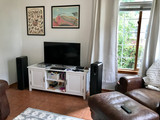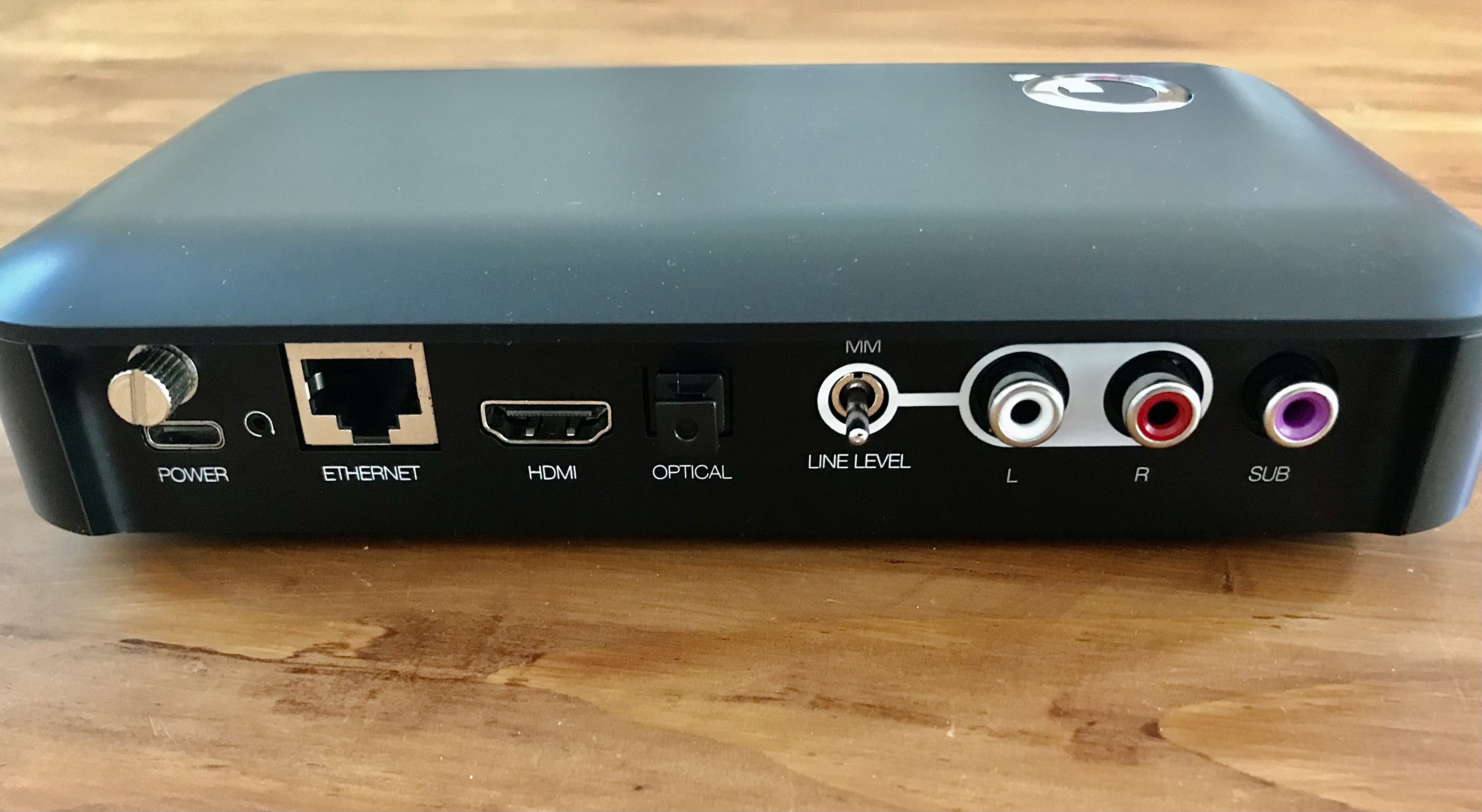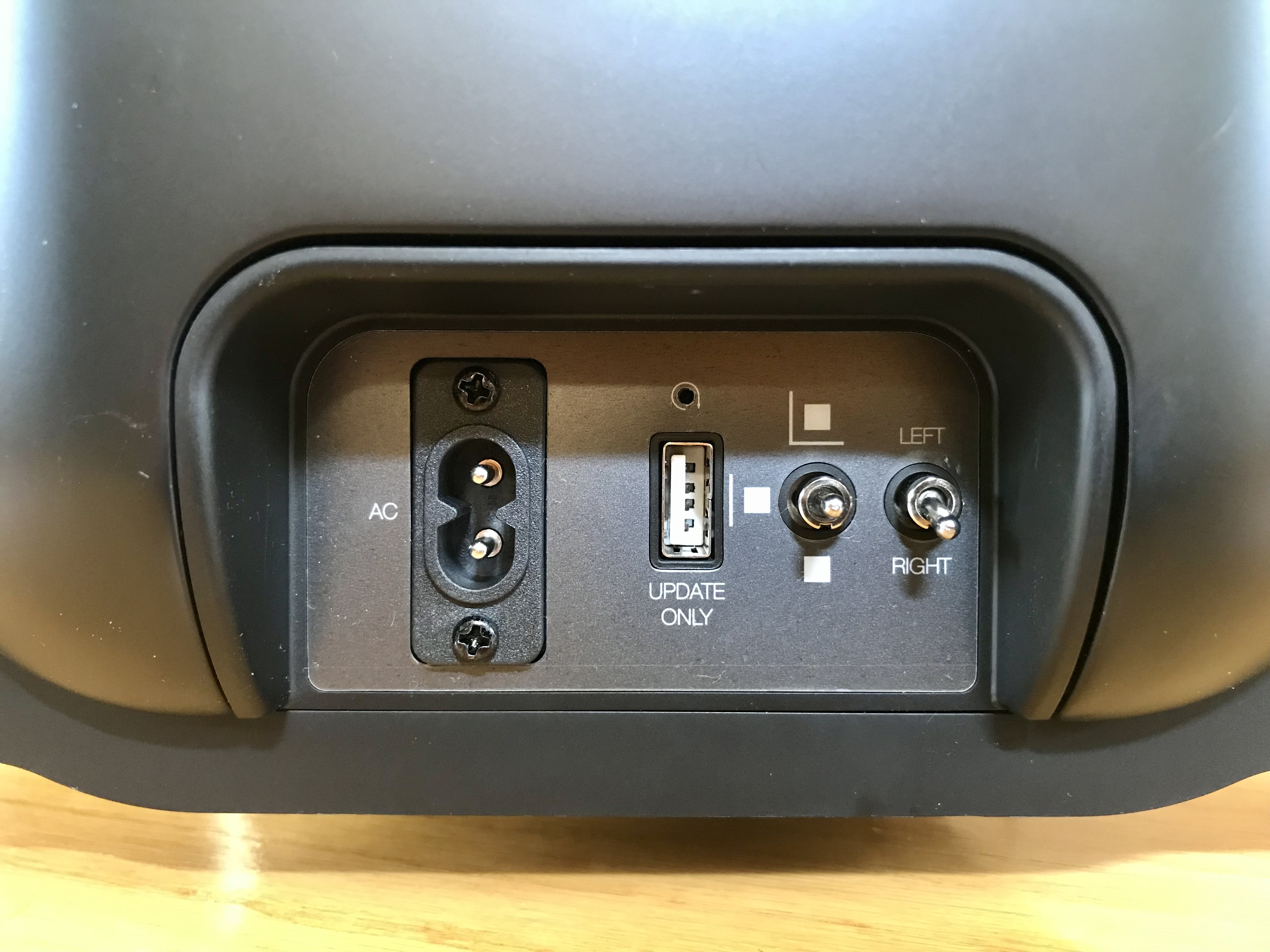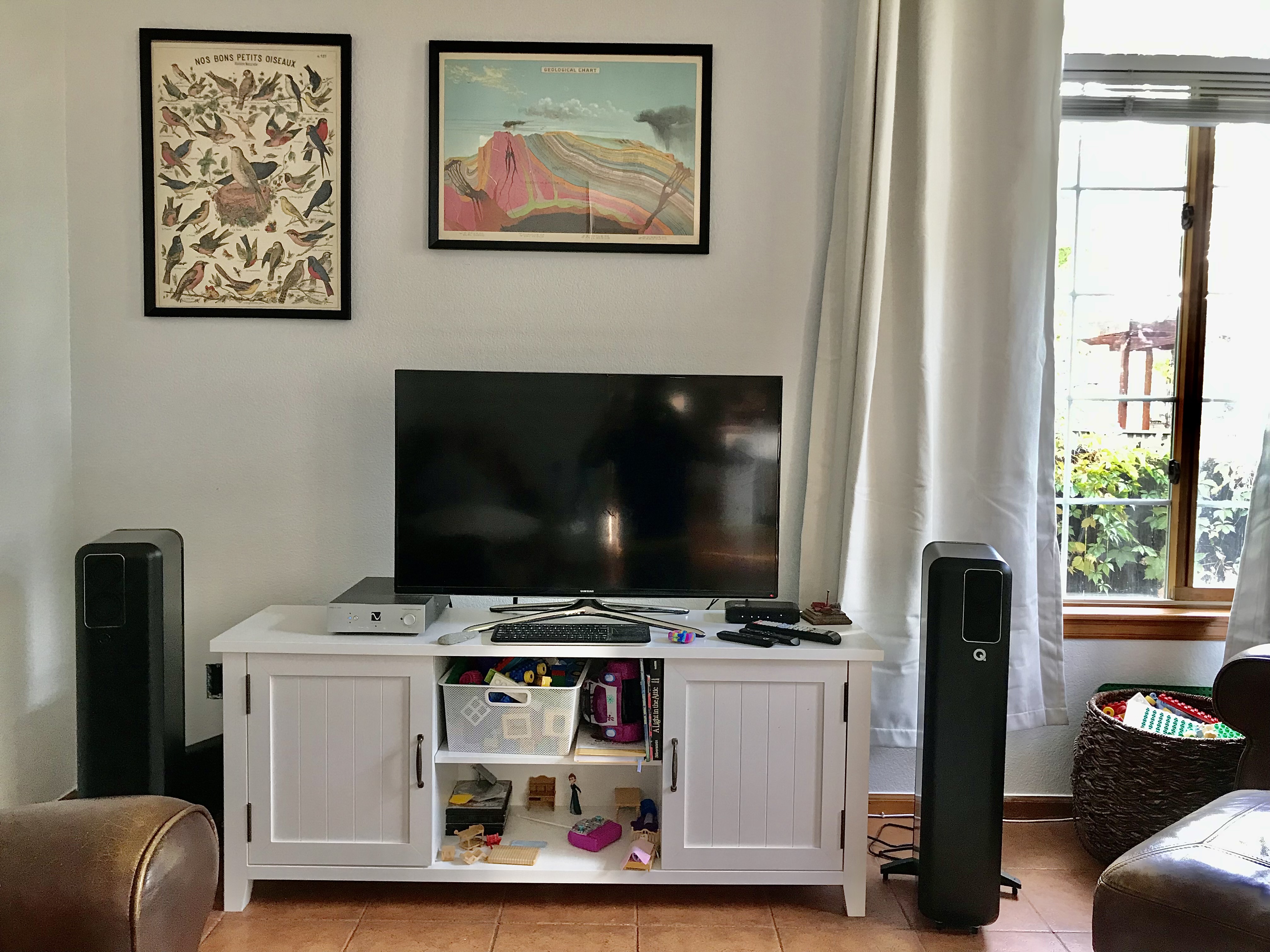TMR Exclusive Review: Q Acoustics Q Active 400 wireless speakers

Tell me something — is it good or bad reviewer technique to try to analyze a pair of speakers while a baby is crying in the next room?
I suppose it depends on the makeup of the acoustic treatment, and whether absorption coefficient is substantial in the baby frequencies…
I kid, of course. And hey- it sounds like the kid is finally settling down in there. But considering the uniqueness of the pair of speakers up for audition, I felt it very appropriate to evaluate them while the family was around.
Is the Q Acoustics Q Active 400 a “lifestyle speaker” that anyone can use? Is it an audiophile gem in wireless, multi-room clothing? Is it a wonderful-sounding solution for those who want few hassles and fewer wires? Just how good does something like this have any business sounding?

These and more questions come to mind when taking in the brand new design from one of TMR’s brand partners, UK-based speaker maker Q Acoustics. The Q Active 400 (and the 200, which is a bookshelf version) are anything but traditional, from plugs to ports. And I don’t know if it was the first moment I laid eyes on them or soon after, but I remember immediately wondering “What does THAT thing sound like?”
A speaker for all
At first glance, the only speaker drivers visible are housed behind a mesh grill that’s flush with the baffle. But these drivers are conspicuously small to be the only things sending sound directly to you. There must be more going on in there, right?
Well the answer to that is yes, and no. One of the coolest features on the speaker side of the design of these involves some modern technology and a couple of audiophile approaches.
But you know, I’ll get to that in a bit. Typical audiophile of me, I have to rush to the specs and find out how this thing is designed… in the process possibly missing the bigger point of what makes the Q Active 400s great. I realize this, and that’s why I’m doing this review differently, listening with and taking the pulse of those around me. My wife, the nanny and my daughter all approve of the looks and sound of these fascinating new speakers, and that kind of response from them about audio gear is rare in my life.
You see, the Q Active 400s aren’t aimed directly at the audiophile, per se. They’re for the audiophile’s family and friends. They integrate with an audiophile’s library and streaming services seamlessly, and they’re a way to get surprisingly good sound into rooms and places where you wouldn’t want to set up a serious hifi system anyway.
Outside of the HiFi-sphere, we live in a world of pint-sized bluetooth speakers, ceiling mounted two-ways and other hideous-sounding ways people who don’t want to fuss with tech listen to music, and Q Acoustics now offers something which sounds — and looks — much, much better. When was the last time you saw a Bluetooth speaker that’s Roon Ready and has an MM phono input?
Q Acoustics is aiming to lift the bar with the Q Active 400 and 200 speakers. Let’s dig in a bit to the technology behind the curious powered speakers.
BMRs are Bad Mothers
Those tiny drivers looking back at you from the otherwise smooth and bare front baffles harbor some very cool technology, which, as a DIYer and speaker builder myself I’ve been aware of and interested in for some time. Balanced Mode Radiators are a new type of speaker driver design, and they create a lot of sound from a very little package.

Invented for use in soundbars, these little wonders look like regular, if miniature speakers, except instead of cones they sport a flat disc, which makes them resemble passive radiators. But passive, they are not. BMRs can be quite linear at large excursions relative to their tiny “cone” size, they can transition to directional sound and produce linear treble with little in the way of “breakup”, and, perhaps most importantly, they have incredibly wide natural dispersion across all frequencies — even treble.
This means they put out more complete sound energy in a wider area than most speakers. Added to the other qualities, what we’re looking at is an exceptional full range driver designed for these innovative floorstanders and bookshelves. Both the Q Active 400 and the Q Active 200 sport two of these small BMR drivers per speaker, located off-center (avoiding diffraction issues) and near the top.
The mighty little BMR drivers are truly impressive, but they’ll still need some help in the bass region. They hold their own down quite low in the frequency range despite their size, and are eventually crossed over over down at 150Hz,where two cleverly implemented internal subwoofers take over.
The blend is excellent (it should be — the crossover uses DSP and avoids phase disruption), and the Q Active 400s produce a balanced and detailed response. Leaving the full rangers to play most of the spectrum with no analog crossover filters in the way — the audiophile approach I mentioned at the beginning — is a killer way to get fantastic impulse response, which delivers tactile transients and extremely natural treble.
Get the impulse response right, and the rest, including frequency response and power response, fall into place. Some of the greatest loudspeaker designers in HiFi audio’s history have believed this to be true, and it’s just exciting to see that kind of philosophy implemented into a modern pair of wireless speakers.
Power up
Another audiophile design point is the use of individual amplifiers to power each and every driver. Following the advancement and refinement of Class D amplifier technology in the last 20 years, more manufacturers are employing this approach these days, for good reason. No driver shares power with another driver, nor does it share the back EMF (electro-motive force) of other drivers in the speaker. There is a distinct clarity and “drive” to the sound of this approach in powered speakers, and the impressive acoustical design of the Actives is given the best chance to shine.
Latest and greatest

Let’s turn our attention to the Bits and Bytes inside the Actives. Q Acoustics engineers clearly wanted to connect with all modern sources — this is a thoroughly modern speaker, after all. The beating heart of the Q Active system is a small device called the Hub, which houses all the inputs and beams the sound to the speakers, via a 5.8Ghz connection. Besides the aforementioned Bluetooth and moving magnet phono inputs (the latter can be switched to an analog line level input to boot), we’ve got DLNA, HDMI and S/PDIF via optical Toslink as well.
The Hub comes preconfigured either for use with Amazon “Works With Alexa” or Google “Chromecast built-in” (selectable at check-out), but either version offers the rest of the connection options, including also Apple Airplay 2 and Roon. I brought home the Google-based Hub, though I was intending to use Roon on apple devices.
By the way, Alexa connectivity is still in development and scheduled to be released in 2022, so making that choice will involve some patience if your dream is to talk to your floorstanding speakers and have them respond. But with so many alternative input options it doesn’t strike me as any kind of sensible reason to wait.
Integration with my Roon service was seamless and simple. Being Roon Ready means the Q Active 400s simply show up in the audio settings menu as an available output. All I had to do was find the zone, name the zone and click “enable,” and the music started playing.
Room aware

Initially, I set the speakers up in front of my HiFi rig in my listening room, which is naturally the best-sounding room in the house. The Q Active 400s offer clever boundary-condition adjustments via a rear switch, compensating for the effect of wall and corner sound wave reflections when placed in a more typical home location. But in my listening room, they were allowed to be out and proud like a proper set of HiFi speakers, so I turned the compensation off. I wanted to first give the 400s the best chance to sound great so I could see if they did any of the audiophile things before I started testing them in typical terrible locations throughout the house.
To my surprise, the Q Active 400s flew their audiophile flag with gusto. Not only were they able to project a clear center image, the mighty BMRs also managed to cast a satisfyingly wide soundstage in a large room. Their subwoofer brethren proved so capable of filling the space with bass so convincingly, I did actually go check that my real subwoofers were not on and somehow getting fed a signal.
All of this shock and awe was nothing, however, compared to the impression they left when I jammed them against the wall and corner of the worst sounding room in my house, flanking the TV and entertainment center. Moving the boundary-condition switch to the appropriate settings (corner for the left speaker and wall for the right), I was absolutely staggered to hear a room-filling, wide soundfield with clear images centered over the TV. It seemed that there was no bad spot to listen in the entire room, whether it was dialogue, sound effects or music playing.
Even fed an audiophile-level recording, the Q Active 400 speakers simply shined in this difficult scenario. HH, the lovely tribute record by longtime Herbie Hancock guitarist Lionel Loueke, sounded nearly as impressive with the 400s in the corner as it did when they were in the listening room. That shouldn’t be possible.
Summing up

I could see a pair of these speakers filling my in-laws’ beach house with beautiful sound. I’m looking at a pair perfectly integrating with my awkwardly positioned TV. The Q Active 400s are not very large, and I could envision them hiding in the corners of a study or even tucked behind a couch or chair in an open area. Heck, with the multi-room capability, I’m imagining a set of these on every floor of a swanky hotel. Think about hearing great imaging and transients as you step off the elevator! Now that’s high class.
These things are so flexible, and their connectivity so broad and simple, they can go anywhere and deliver smiles and toe taps galore. They’re designed using audiophile techniques and they’re aimed at the no-fuss crowd. They have an analog and phono input, for goodness’ sake, along with every digital input you’d want.
Their sound is fun, fleshy and detailed without any kind of “digital” sound — quite a feat for a very digital pair of speakers. And while they can do some audiophile tricks like proper imaging and killer transients, it’s the way they sound outside the “sweet spot” that endears them to the entire household.
I can’t think of a competitor in the market for the Q Active 400 and 200 speakers. Until now, no one device has been able to satisfy both audiophiles and the rest of the world (save, perhaps the mega-buck Meridian products, though they aren’t for everyone either), and it seems Q Acoustics saw a need and stepped in to get it done. That I am impressed with the whole package is a huge understatement.
When you look around the industry right now, some of the biggest excitement centers around products like the new Purifi amplifier modules and products like these speakers. HiFi is rewarding, and Ultra-Fi is exciting, but the reasonably-priced products that “slam” make right now one of the best times to be a music lover.
